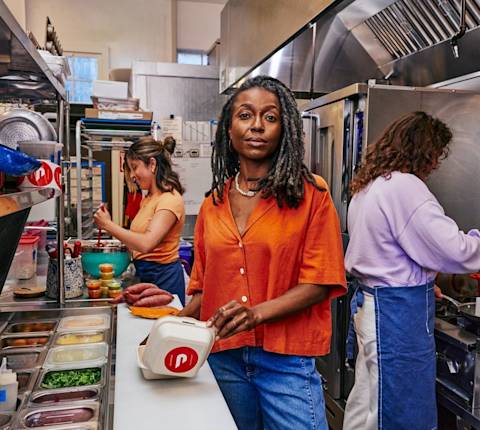If your restaurant does not offer delivery, now is the time to start. One report estimated that online food delivery generated $18 billion in revenue in 2019, and will grow to $24 billion by 2023.
When it comes to adding delivery to your restaurant, operators have two options: launch your own delivery service or partner with a third party.
Benefits of third party food delivery service
Adding delivery to your restaurant by partnering with a third party technology platform has a number of advantages:
Reach thousands of customers already on delivery platforms. A recent study found that 63% of adults ages 18 to 29 have used a food delivery app in the past 90 days, followed by 51% of 30- to 44-year-olds and 29% of 45- to 60-year-olds. Partnering with a platform like DoorDash can help you reach these customers so you can grow your delivery sales.
Get marketing support. Technology platforms like DoorDash help restaurants increase their brand awareness and boost their SEO, so your delivery menu gets in front of more diners.
Focus on the food, not the logistics. DoorDash's technology platform provides restaurants with built-in ordering and payments technology, a seamless online ordering experience, and Dashers to deliver orders so restaurants can focus on what they do best — making delicious food.
These benefits are why third party technology platforms typically charge a commission to help you add delivery to your restaurant.
How to launch your restaurant's own food delivery service
Many restaurants choose to build their own food delivery program in-house rather than partner with a technology platform. While this option requires a lot more effort and time, it does allow you to fully control the delivery experience. Take a look at these 13 steps for adding delivery to your restaurant to see if it's right for your business.
1. Hire and train delivery drivers
Recruit delivery drivers by posting listings on job boards and career sites like Indeed, Monster, or even Craigslist, then review applications and conduct interviews. Once you've narrowed down your candidates, confirm they have a legal driver's license, run a background check, and review their DMV driving records. After hiring your drivers as employees or contractors, confirm their work availability, complete their tax forms, and add them to your payroll. Finally, create an onboarding and training program (including guidelines for COVID-19) so they provide your customers with a reliable and safe delivery experience.
2. Set up delivery vehicles
Decide whether you want your drivers to use their own vehicles, or if you'll purchase a vehicle fleet for them. Either way, figure out whether you will track and reimburse drivers for their gas usage, and make sure you have ample parking spots for drivers to quickly pick up delivery orders from your restaurant.
3. Get insurance policies
While you likely already have general liability insurance for your restaurant business, you may need to add auto insurance plus additional delivery driver-specific policies to cover injuries, property damage, workers' compensation, and more.
4. Purchase delivery equipment
Set your delivery drivers up for success with the proper equipment. Purchase a variety of insulated bags (e.g., totes, pizza bags, biker bags, etc.) to keep food hot or cold, as well as drink carriers to protect beverages during transport. Help your customers easily identify your drivers by providing magnetic stickers for their vehicles and branded T-shirts, hats and hoodies. Finally, purchase a steady supply of Personal Protective Equipment (PPE), including hand sanitizer, masks and plastic gloves to keep your drivers and customers healthy.
5. Figure out your pricing
Calculate pricing and fee structures that enable a profitable food delivery program. On the customer side, determine whether your delivery fee will be a flat rate or a percentage of the order. Some restaurants also charge higher prices for delivery menu items in order to cover delivery expenses. On the driver side, determine an hourly rate that will attract top-tier drivers but doesn't cut too much into your profits. Once you decide, be sure to factor your delivery business into your P&L statement.
6. Tackle delivery logistics
Adding delivery to your restaurant on your own requires a lot of logistics. You'll have to determine a delivery radius that allows for both a high volume of orders and timely deliveries. Aim to fulfill deliveries within one hour to keep up with customer expectations — though many third party platforms complete deliveries in less time. Ideally, you'll also be able to provide customers with an estimated delivery time and a tracker to locate drivers during delivery. Finally, get valuable customer feedback by implementing a five-star rating and review system, which will help you identify drivers who are top performers or need additional training.
7. Develop your delivery menu
Your delivery menu should be a streamlined version of your regular dine-in menu. Focus on higher-margin items, best-sellers, dishes that can be prepped in advance, and dishes that travel well. Be sure to include appetite-inducing photos for every item, which help to drive delivery orders and add-ons. Ensure delivery food quality by focusing on food that travels well.
8. Set up online ordering
If you're launching a food delivery service, set up online ordering in addition to (or instead of) phone orders. NPD research revealed that online orders via mobile app, website, or text message has grown by 23% over the last four years to generate $26.8 billion dollars.
Hire a web designer and/or developer to create a visually appealing, user-friendly and mobile-optimized online ordering website. Your website should enable customers to view your menu, place orders, make customizations, add their delivery address, send credit card payments, give tips, and more. DoorDash Online Ordering allows you to quickly add a branded online ordering store to your website, so you can accept commission-free orders, with no monthly fee for the software. Instead, you pay payment card processing fees of 2.9% of the total transaction amount + $0.30 per order.

9. Establish delivery workflows
Ahead of launching your food delivery service, set up your kitchen operations to ensure a smooth, efficient flow from receiving an order, sending it to your kitchen for preparation, packaging it, dispatching drivers, and finally confirming the delivery reached your customer. Ideally, you can automate these steps with technology so you don't have too many staff members involved — just make sure your restaurant has a strong wifi connection. Consider integrating the delivery orders directly into your POS system to minimize errors. You also may want to reconfigure your restaurant kitchen floor plan to maximize efficiency.
10. Designate a delivery pickup area
Create a space in your restaurant for kitchen staff to place delivery orders once they're ready for drivers to pick up. Stock this area with to-go bags and tamper-proof stickers, as well as condiments, sauces, napkins, and disposable utensils. Develop a system for organizing your orders (e.g., by pickup time, order number, alphabetically by customer name, etc.) so drivers can easily grab the right order and be on their way.
11. Invest in the right packaging
Successful off-premise operations require a steady supply of transport-friendly takeout containers and utensils. Choose a variety of durable packaging sizes and shapes to prevent your items from spilling or falling apart. Additionally, take steps to ensure food quality, such as placing hot and cold items in separate bags, and using ventilated containers for hot food. Finally, package sauces, broth, and dressings separately so your dish doesn't get soggy in transit.
12. Market your delivery offering
Now that you've added delivery to your restaurant, it's time to get the word out! Let your existing customers know how they can place delivery orders, and reach new customers by adding your online ordering link to your restaurant website, Google My Business profile, social media channels, and email newsletter. Place physical signage in your restaurant and stickers on your windows to let passersby know you offer delivery. With the proper promotion, you'll be able to quickly start generating delivery sales.
13. Track your growth
Once your delivery business is up and running, it’s important to track progress and understand how you can improve. Set up a sales analytics system to understand key delivery metrics like your busiest days and times, most popular menu items, new vs. repeat customers, order sizes, and the impact of promotions and discounts. With these insights, you’ll be able to focus on profitability and grow your delivery business.
Which strategy is right for your business?
Whether you already have your own drivers or want to add delivery to your restaurant from scratch, DoorDash can help you reach more hungry customers. We offer a variety of services to fit your restaurant’s unique needs, including delivery and pickup, self-delivery with your existing delivery fleet, white-label fulfillment, catering, and more.
If you want to focus on making great food instead of delivery logistics, check out our flagship product, DoorDash Marketplace.
Already have your own drivers? You can still reach the DoorDash customer base and increase delivery orders at a reduced commission with DoorDash Self-Delivery.





